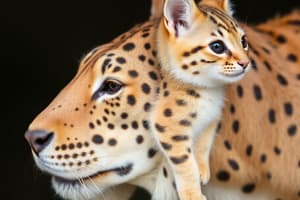Podcast
Questions and Answers
Name a mammal that belongs to the class Mammalia.
Name a mammal that belongs to the class Mammalia.
Elephant (Loxodonta africana)
What type of animals are covered in scales or scutes and belong to the class Reptilia?
What type of animals are covered in scales or scutes and belong to the class Reptilia?
Reptiles
Provide an example of a bird that belongs to the class Aves.
Provide an example of a bird that belongs to the class Aves.
Eagle (Haliaeetus leucocephalus)
Which class of animals transitions from water to land and includes species like frogs and salamanders?
Which class of animals transitions from water to land and includes species like frogs and salamanders?
What are mammals characterized by that help in feeding their young?
What are mammals characterized by that help in feeding their young?
Name a cold-blooded vertebrate that is covered in scales and belongs to the class Reptilia.
Name a cold-blooded vertebrate that is covered in scales and belongs to the class Reptilia.
Which type of animals have feathers covering their streamlined bodies and belong to the class Aves?
Which type of animals have feathers covering their streamlined bodies and belong to the class Aves?
What distinguishes amphibians from other animal classes in terms of their life cycle?
What distinguishes amphibians from other animal classes in terms of their life cycle?
Give an example of a reptile that belongs to the class Reptilia.
Give an example of a reptile that belongs to the class Reptilia.
Which animal class includes species like penguins and ostriches?
Which animal class includes species like penguins and ostriches?
Study Notes
Exploring Animal Classification: Mammals, Reptiles, Birds, Amphibians, and Insects
Our planet teems with diverse life forms, yet we organize them into manageable groups using scientific classification—also known as taxonomy. Understanding these groups helps us comprehend nature's intricate web of relationships.
The six-kingdom Linnaean classification scheme (developed in the 1700s) organizes animals into the following categories:
- Mammals: Characterized by mammary glands producing milk for feeding young. Examples: Elephant (Loxodonta africana), Bear (Ursus americanus), Kitten (Felis silvestris catus).
- Further divisions include Primates (apes, monkeys) and Carnivores (dogs, wolves). Humans, as mammals, belong to the class Mammalia.
- Reptiles: Cold-blooded vertebrates covered in scales or scutes. Examples: Lizard (Iguana iguana), Snake (Python regius, Dendroaspis angusticeps), Turtle (Chrysemys scripta elegans). Reptilians belong to the class Reptilia.
- Birds: Warm-blooded vertebrates with feathers covering streamlined bodies. Examples: Eagle (Haliaeetus leucocephalus), Penguin (Spheniscus demersus), Ostrich (Struthio camelus). Avian species reside in the class Aves.
- Amphibians: Cold-blooded vertebrates that begin their lives in water before transitioning onto land. Examples: Frog (Rana temporaria), Toad (Bufo bufo), Salamander (Salamandra salamandra). Amphibians belong to the class Amphibia.
- Insects: Small, winged, hexapods with hard outer coverings. Examples: Ant (Formica spp.), Butterfly (Danaus plexippus), Dragonfly (Sympetrum striolatum). Insects fall under the phylum Arthropoda.
These groups are the foundation of our knowledge regarding animals, providing a universal framework for communication among scientists and the public alike. Through classification, we assign each creature its proper place in the grand tapestry of life.
While this structure encompasses countless species, it serves as merely a snapshot of our current understanding. With ongoing discoveries and new insights, taxonomic hierarchies remain fluid and ever-evolving.
Studying That Suits You
Use AI to generate personalized quizzes and flashcards to suit your learning preferences.
Description
Explore the scientific classification of animals into major groups like mammals, reptiles, birds, amphibians, and insects. Learn about distinctive characteristics and examples within each group, understanding how taxonomy helps us organize and comprehend the diverse forms of life on Earth.




